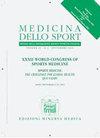游泳自由泳的技术和协调
IF 0.6
4区 医学
Q3 MEDICINE, GENERAL & INTERNAL
引用次数: 0
摘要
背景:不对称和游泳成绩之间的联系已经被强调。推进不对称也可能增加受伤率。本研究的目的是评估优秀和青少年竞技男女游泳运动员在爬泳动作中上肢不对称。方法:选取精英组(G1)和青少年组(G2) 20名竞技游泳运动员(男、女各10名)。测试由三个部分组成。在无侧呼吸的情况下,以最高速度进行自由泳试验。两项试验只用一只手臂完成,第三项试验用两只手臂完成。通过录像来评估笔划的速度、频率、长度和持续时间。加速度由放置在头部的惯性传感器记录。结果:G1组脑卒中长度大于G2组,卒中频次小于G2组。统计结果显示,女性游泳运动员的泳姿长度较短。G1组速度显著高于G2组,卒中次数显著低于G2组。男性的速度在统计学上高于女性,而中风次数则低于女性。所有被试的优势肢游泳速度均高于非优势肢游泳速度。通过惯性传感器测量的加速度在G1和G2、优势肢和非优势肢、男性和女性之间无统计学差异。结论:优势肢与非优势肢推进力的显著差异表明,游泳技术分析应更多地考虑对划水对称性的分析,以提高运动员的成绩和幸福感。本文章由计算机程序翻译,如有差异,请以英文原文为准。
Tecnica e coordinazione della bracciata a stile libero nel nuoto
BACKGROUND: The link between asymmetries and swimming performance has been highlighted. Propulsion asymmetries may also increase injury rates. Aim of the present study was to assess upper limb asymmetries in the front crawl stroke of elite and youth competitive male and female swimmers.METHODS: Participants were 20 competitive swimmers (10 male and 10 female) of elite (G1) and youth categories (G2). The tests consisted of three 25.m freestyle trials at maximum speed with no lateral breathing. Two trials were completed with one arm only, the third one with both arms. Speed, stroke frequency, length and duration of the strokes were evaluated using video footage. Acceleration was recorded by an inertial sensor placed on the head.RESULTS: Stroke length was statistically greater and the stroke frequency lower in G1 than G2. Stroke length resulted statistically shorter in female swimmers. G1 speed resulted statistically higher and the number of strokes lower than G2. Males speed was statistically higher and the number of strokes lower than females. Speed in swimming with the dominant limb was statistically higher then with the non-dominant limb for all subjects. Accelerations measured through the inertial sensor resulted non statistically different between G1 and G2, dominant and non-dominant limb, or males and females.CONCLUSIONS: The detection of significantly different propulsions between the dominant and the non-dominant limb could indicate that the analysis of the swimming technique should take into a greater account the analysis of the symmetry of the stroke to improve both performance and well-being of the athletes.
求助全文
通过发布文献求助,成功后即可免费获取论文全文。
去求助
来源期刊

Medicina Dello Sport
医学-医学:内科
CiteScore
1.10
自引率
50.00%
发文量
55
审稿时长
>12 weeks
期刊介绍:
The journal Medicina dello Sport, official journal of the Italian Federation of Sports Medicine (FMSI), is an external peer-reviewed scientific journal, publishes scientific papers on sports medicine.
 求助内容:
求助内容: 应助结果提醒方式:
应助结果提醒方式:


